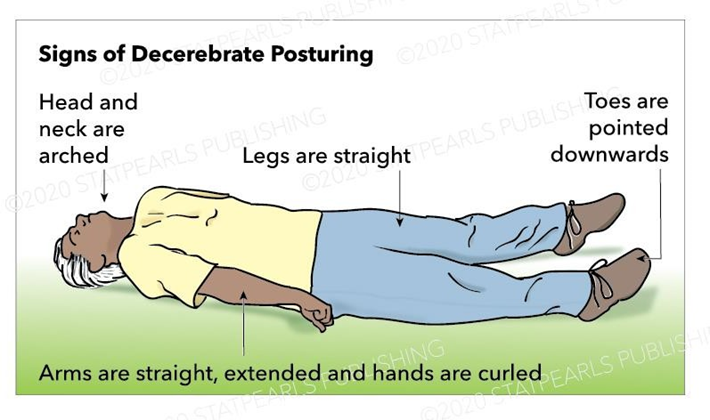The nurse is reviewing the record of a child with increased intracranial pressure and notes that the child has exhibited signs of decerebrate posturing. On assessment of the child, the nurse expects to note which characteristic of this type of posturing?
Adduction of the arms at the shoulders
Abnormal flexion of the upper extremities and extension and adduction of lower extremities
Flaccid paralysis of all extremities
Rigid extension and pronation of the arms and legs
The Correct Answer is D
D. This is the correct characteristic of decerebrate posturing. Decerebrate posturing is characterized by rigid extension and pronation (turning inward) of the arms and legs. It indicates severe neurological dysfunction and increased intracranial pressure, often involving damage to the brainstem.

A. This characteristic is not associated with decerebrate posturing. Adduction refers to movement toward the midline of the body, which is not typically observed in decerebrate posturing.
B. This description is not characteristic of decerebrate posturing. Decerebrate posturing involves extension, not flexion, of the upper extremities, along with extension and pronation (not adduction) of the lower extremities.
C. Flaccid paralysis refers to the absence of muscle tone and movement, which is not characteristic of decerebrate posturing. Decerebrate posturing involves increased muscle tone and abnormal, rigid extension of the arms and legs.
Nursing Test Bank
Naxlex Comprehensive Predictor Exams
Related Questions
Correct Answer is A
Explanation
A. Wheezing, which is a high-pitched whistling sound heard during expiration, is a common symptom of asthma. It occurs due to narrowed airways and airflow obstruction, often in response to triggers such as allergens, respiratory infections, or exercise.
B. Low-grade fever in the afternoon is not typically associated with asthma. Fever is more commonly seen in response to infections, such as respiratory infections, which can exacerbate asthma symptoms but is not a direct manifestation of asthma itself.
C. Without the complete statement, it is difficult to assess its relevance to asthma symptoms. However, an abrupt onset of symptoms, such as sudden shortness of breath or chest tightness, may occur during an asthma attack or exacerbation.
D. Sharp pleuritic pain is not a typical finding in asthma. Pleuritic pain, which is sharp and worsened by breathing, is more commonly associated with conditions affecting the pleura, such as pneumonia or pleurisy.
Correct Answer is ["3.1"]
Explanation
1kg = 2.205lbs Weight in kgs= 9.979
Desired dose= 10mg/kg Dose= 99.79mg
Volume= desired dose/ available concentration per ml Volume= 99.79mg/ 32
Volume= 3.12mls
Therefore, the nurse should administer 3.1mls
Whether you are a student looking to ace your exams or a practicing nurse seeking to enhance your expertise , our nursing education contents will empower you with the confidence and competence to make a difference in the lives of patients and become a respected leader in the healthcare field.
Visit Naxlex, invest in your future and unlock endless possibilities with our unparalleled nursing education contents today
Report Wrong Answer on the Current Question
Do you disagree with the answer? If yes, what is your expected answer? Explain.
Kindly be descriptive with the issue you are facing.
